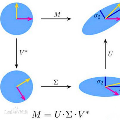Holographic multiple-input multiple-output (MIMO) is deemed as a promising technique beyond massive MIMO, unleashing near-field communications, localization, and sensing in the next-generation wireless networks. Semi-continuous surface with densely packed elements brings new opportunities for increased spatial degrees of freedom (DoFs) and spectrum efficiency (SE) even in the line-of-sight (LoS) condition. In this paper, we analyze holographic MIMO performance with disk-shaped large intelligent surfaces (LISs) according to different precoding designs. Beyond the well-known technique of orbital angular momentum (OAM) of radio waves, we propose a new design based on polar Walsh functions. Furthermore, we characterize the performance gap between the proposed scheme and the optimal case with singular value decomposition (SVD) alongside perfect channel state information (CSI) as well as other benchmark schemes in terms of channel capacity. It is verified that the proposed scheme marginally underperforms the OAM-based approach, while offering potential perspectives for reducing implementation complexity and expenditure.
翻译:暂无翻译



